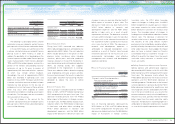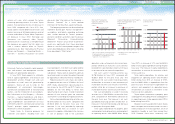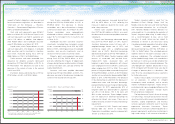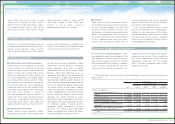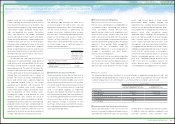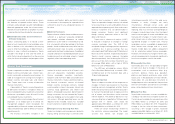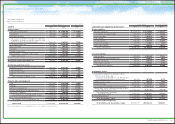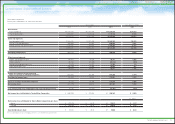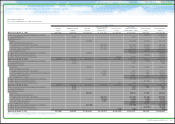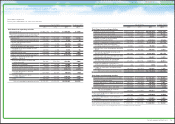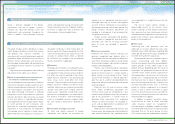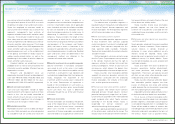Toyota 2011 Annual Report Download - page 66
Download and view the complete annual report
Please find page 66 of the 2011 Toyota annual report below. You can navigate through the pages in the report by either clicking on the pages listed below, or by using the keyword search tool below to find specific information within the annual report.
Legislation Regarding End-of-Life Vehicles
Related Party Transactions
Recent Accounting Pronouncements in the United States
Critical Accounting Estimates
0822
Financial Section and
Investor Information
Business and
Performance Review
Special FeatureMessage/Vision
Management and
Corporate Information
Management's Discussion and Analysis of Financial Condition and Results of Operations
In October 2000, the European Union enforced a
directive that requires member states to promul-
gate regulations implementing the following:
• manufacturers shall bear all or a significant
part of the costs for taking back end-of-life
vehicles put on the market after July 1, 2002
and dismantling and recycling those vehicles.
Beginning January 1, 2007, this requirement
will also be applicable to vehicles put on the
market before July 1, 2002;
• manufacturers may not use certain
hazardous materials in vehicles sold after
July 2003;
• vehicles type-approved and put on the
Toyota does not have any significant related party transactions other than transactions with affiliated
companies in the ordinary course of business. See note 12 to the consolidated financial statements for
further discussion.
market after December 15, 2008 shall be
re-usable and/or recyclable to a minimum
of 85% by weight per vehicle and shall be
re-usable and/or recoverable to a minimum
of 95% by weight per vehicle; and
• end-of-life vehicles must meet actual re-use
of 80% and re-use as material or energy of
85%, respectively, of vehicle weight by
2006, rising to 85% and 95%, respectively,
by 2015.
See note 23 to the consolidated financial
statements for further discussion.
Yen in millions
Total
amounts
committed
Amount of Commitment Expiration Per Period
Less than
1 year
1 to 3
years
3 to 5
years
5 years
and after
Commercial Commitments (note 23):
Maximum potential exposure to guarantees
given in the ordinary course of business ¥1,662,225 ¥469,543 ¥744,991 ¥316,508 ¥131,183
Total Commercial Commitments ¥1,662,225 ¥469,543 ¥744,991 ¥316,508 ¥131,183
In October 2009, the Financial Accounting
Standards Board (“FASB”) issued updated
guidance of accounting for and disclosure of
Revenue Recognition with Multiple Deliverables.
This guidance allows the use of estimated selling
price for determining the selling price of deliver-
ables, eliminates the residual method of allocation
and expands the disclosures related to a vendor’s
multiple-deliverable revenue arrangements. This
guidance is effective prospectively for revenue
arrangements entered into or materially modified
in fiscal year beginning on or after June 15, 2010.
Management does not expect this guidance to
have a material impact on Toyota’s consolidated
financial statements.
The consolidated financial statements of Toyota
are prepared in conformity with accounting
principles generally accepted in the United States
of America. The preparation of these financial
statements requires the use of estimates,
judgments and assumptions that affect the
reported amounts of assets and liabilities at the
date of the financial statements and the reported
amounts of revenues and expenses during the
periods presented. Toyota believes that of its
significant accounting policies, the following may
involve a higher degree of judgments, estimates
and assumptions:
Toyota generally warrants its products against
certain manufacturing and other defects. Provisions
In April 2011, FASB issued updated guidance
to clarify the accounting for and disclosures about
troubled debt restructurings by creditors. This
guidance provides the criteria as to whether a
loan modification constitutes a troubled debt
restructuring and requires additional disclosures
about troubled debt restructurings. This guidance
is effective for the interim period or the fiscal year
beginning on or after June 15, 2011, and shall be
applied retrospectively to the beginning of the
fiscal year of adoption. Management does not
expect this guidance to have a material impact on
Toyota’s consolidated financial statements.
for product warranties are provided for specific
periods of time and/or usage of the product and
vary depending upon the nature of the product,
the geographic location of the sale and other
factors. All product warranties are consistent with
commercial practices. Toyota includes a provision
for estimated product warranty costs as a
component of cost of sales at the time the related
sale is recognized. The accrued warranty costs
represent management’s best estimate at the
time of sale of the total costs that Toyota will incur
to repair or replace product parts that fail while
still under warranty. The amount of accrued
estimated warranty costs is primarily based on
historical experience of product failures as well as
current information on repair costs. The amount of
warranty costs accrued also contains an estimate
of warranty claim recoveries to be received from
Product Warranties and Recalls and
Other Safety Measures
Toyota is unable to make reasonable estimates
of the period of cash settlement with respect to
liabilities recognized for uncertain tax benefits,
and accordingly such liabilities are excluded from
the table above. See note 16 to the consolidated
financial statements for further discussion.
Toyota expects to contribute ¥97,231 million
to its pension plans in fiscal 2012.
66
TOYOTA ANNUAL REPORT 2011





